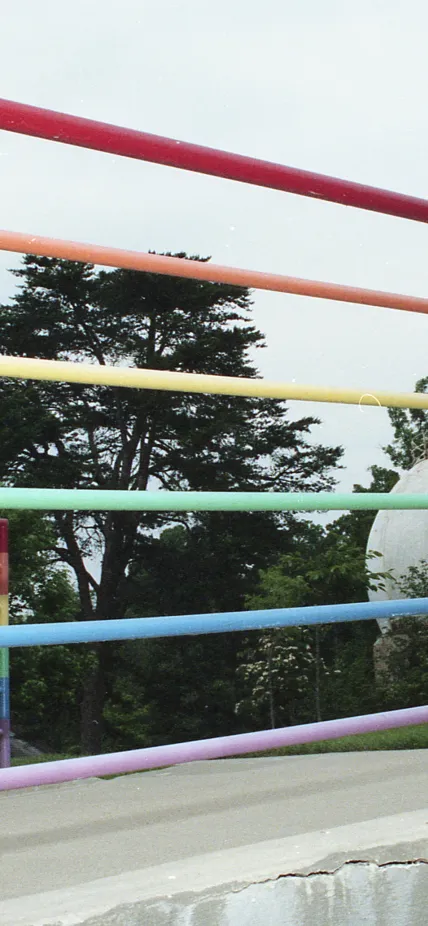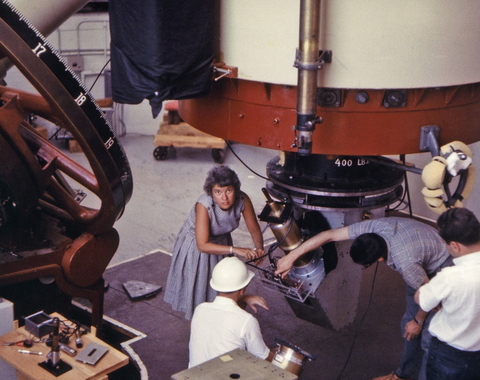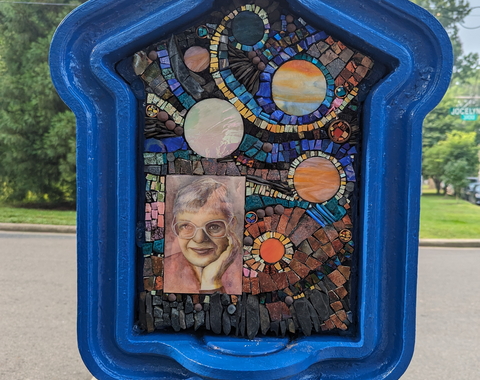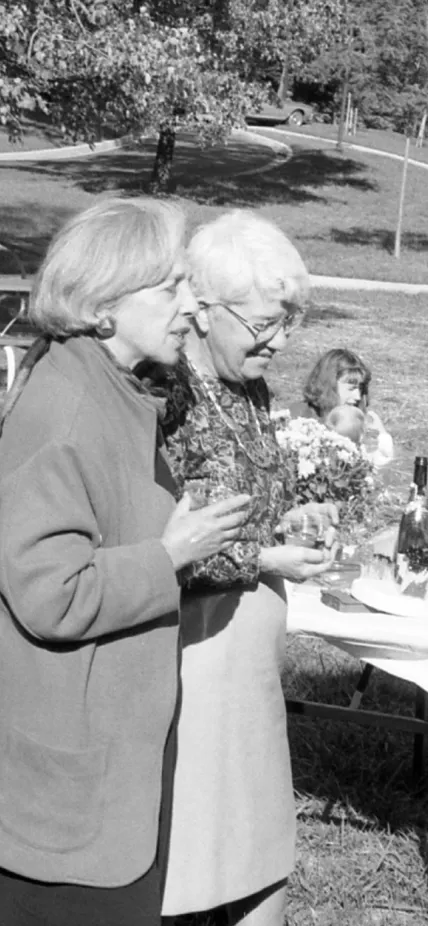1965 was a year of opening doors.
The Civil Rights Movement was gaining momentum, with the Voting Rights Act dismantling restrictions that had long kept many Americans from the polls. At the same time, the Equal Employment Opportunity Commission began challenging workplace discrimination, pushing for fairness regardless of race or gender.
Amid this wave of change, the Cold War rivalry between the U.S. and the Soviet Union ignited a surge of interest in space exploration. NASA’s Mariner 4 provided the first close-up images of Mars, while astronaut Ed White made history as the first American to walk in space.
Carnegie Science was also reaching for the stars—this time through the lens of cutting-edge technology.
Under the leadership of Merle A. Tuve, the Department of Terrestrial Magnetism (now part of the Earth and Planets Laboratory) was on the brink of leveraging a revolutionary tool: Kent Ford’s Image Tube Spectrograph. When attached to a telescope, this instrument promised to greatly enhance the ability to detect faint celestial objects.
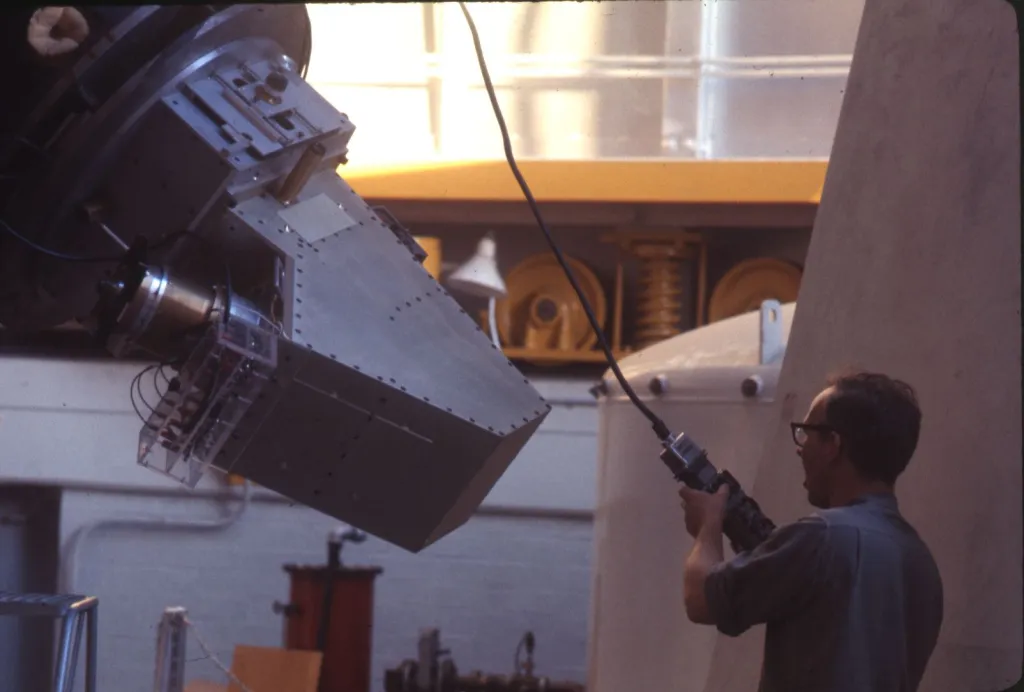
However, this new instrument needed to be tested. That’s where Vera Rubin comes in.
In a world where doors were starting to open for women around the country, Rubin knocked on ours at just the right time, ready to redefine our understanding of the universe.
Vera Comes to Lunch
Rubin wasn’t yet the world-renowned astronomer we know today. She was still in the early stages of her career after obtaining her Ph.D. from Georgetown University in 1954 and spending a decade juggling teaching, researching, and building her family.
By 1964, Rubin was looking to dive back into her research. So, she made a bold decision. She decided to step away from her teaching job to focus on her passion: unraveling the mysteries of galactic movements.
“Teaching and observing and having four children was just more than I wanted to handle,” said Rubin in an interview years later.
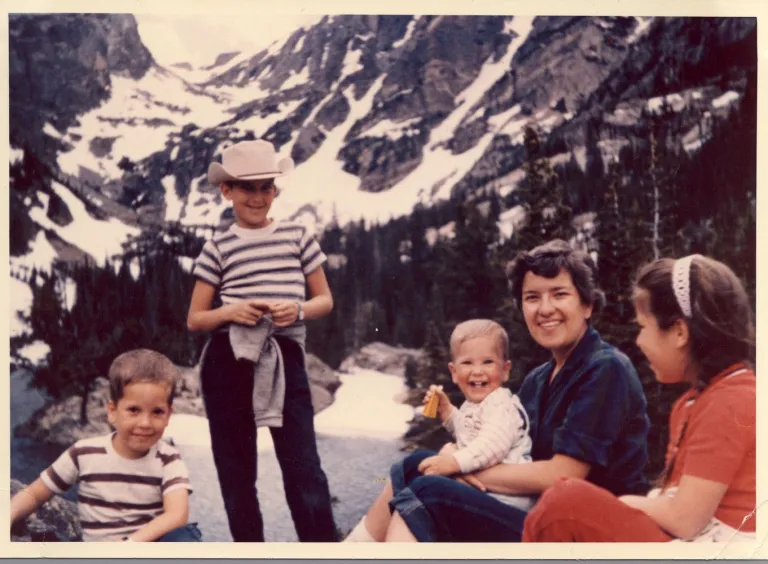
In January 1965, Rubin visited her friend Bernard (Bernie) Burke, an astrophysicist at Carnegie Science. Seeking a research position—and never one to shy away from a problem—Rubin walked into his office and asked for a job outright.
Rubin later remarked that Burke seemed “as surprised as if she’d asked him to marry her.” Presumably because, at the time, the department had no women researchers on staff.
But Burke didn’t brush her off. Instead, he invited her to join the campus community lunch. Director Tuve, perhaps sensing an opportunity, asked Rubin to stand up at a blackboard and explain her work on galaxy rotation. After her presentation, she took an exceptionally fortuitous seat next to Kent Ford.
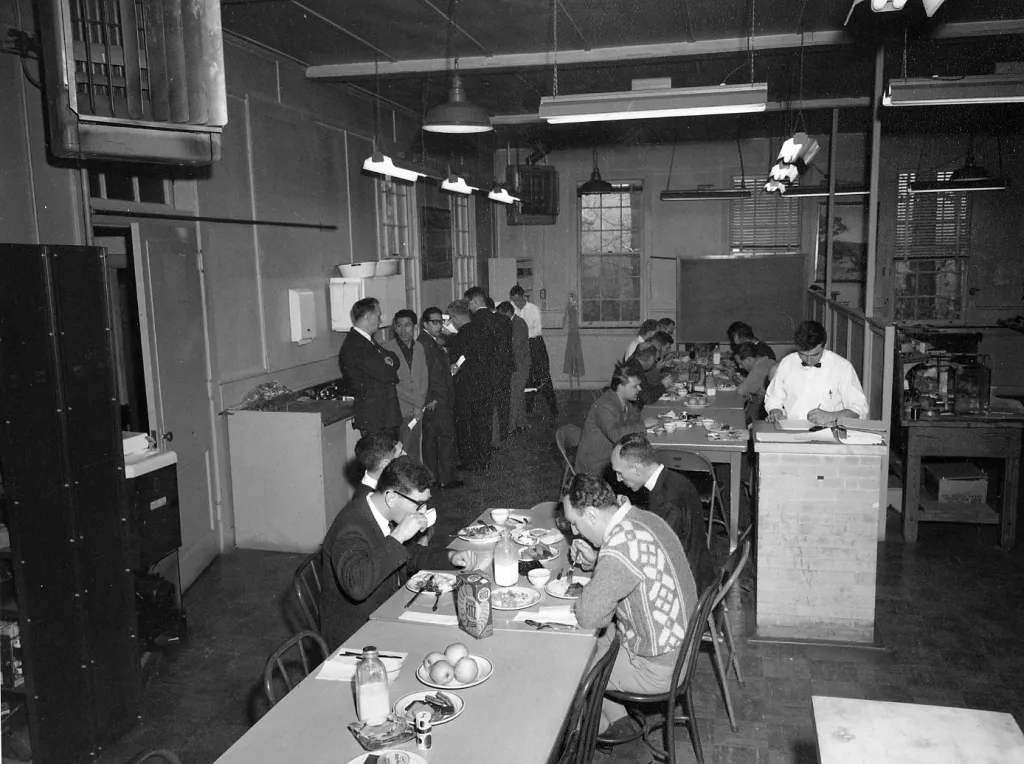
“I did not know that Kent Ford had just built an image-tube spectrograph," recalled Rubin. "I mean, that was just a gift out of the blue."
After this impromptu lunch interview, Rubin was handed a photographic plate from Kent’s work and asked if she could measure the stellar velocities. Rubin took the plate to her office at Georgetown and got to work. Less than three months later, she started her new job as the department's first female staff scientist.
The timing couldn’t have been more perfect. Rubin’s expertise in galaxy spectra and radial velocities was exactly what Tuve and Ford had been looking for. For Rubin, the untapped potential of this new imaging tube was an exciting draw.
Rubin recalled, “Kent was anxious to test the limits of the image tube, and I was anxious to obtain new information about galaxies.”
Together, Rubin and Ford were about to sharpen the universe's focus and expose a mystery hiding in plain sight: dark matter.
Unlocking the Door to Dark Matter
In the late 1960s, Rubin’s fascination with galaxy rotation led her to focus on the neighboring Andromeda galaxy. The Rubin-Ford duo spent nights at the Lowell and Kitt Peak Observatories, making observation after observation thanks to the efficiency of the spectrograph.
In a 2006 article in Physics Today, Rubin recalled, "Using this device on a telescope reduced the exposure time to 1/10th that of an unaided photographic plate. It was a major step forward in telescope instrumentation."
As they processed the images, they expected to see that stars were moving faster near the galaxy’s center and slowing down as they moved out toward the edges, just as Newtonian physics would predict. But the data told a completely different story.
“The surprises came very quickly,” wrote Rubin. “By the end of the first night, we were puzzled by the shape of the rotation curve.”

![Vera Rubin at Lowell Observatory, 69-inch [i.e., 72-inch] Telescope (Kent Ford in white helmet)](/sites/default/files/styles/embed_medium/public/2024-09/DTM_VR-B-011_19650000.jpg.webp?itok=QMRMh-hZ)
Instead of the expected drop in speed at the galaxy’s edges, the stars seemed to all be moving at the same rate, no matter where they were in the galaxy. When they plotted the data, the curve was flat, not the steep slope they had anticipated. This “flat curve” hinted that something unseen was adding mass to the galaxy.
Rubin proposed that this missing mass was dark matter—an invisible substance that doesn’t emit light or energy. We now know this invisible material makes up more than 85 percent of the universe.
In 1970, Rubin and Ford published those initial findings on Andromeda’s flat curve, but Rubin knew she would need more evidence to understand what was going on—and to convince a skeptical scientific community. Over the next decade, the duo observed galaxy after galaxy. By 1980, they had amassed a mountain of evidence. Their culminating paper showed the flat curve phenomenon in twenty-one different spiral galaxies.
In the paper, Rubin wrote, “The conclusion is inescapable that non-luminous matter exists beyond the optical galaxy.”

By 1985, Rubin’s work had gained worldwide recognition. She presented her findings at the International Astronomical Union (IAU), where she argued for the reality of dark matter on a global stage.
“In a spiral galaxy, the ratio of dark-to-light matter is about a factor of 10,” she explained to the IAU. “That’s probably a good number for the ratio of our ignorance to knowledge. We’re out of kindergarten, but only in about third grade.”
Rubin’s groundbreaking research earned her a place among the scientific elite. She was elected to the National Academy of Sciences in 1981, awarded the National Medal of Science in 1993, and received the Royal Astronomical Society’s Gold Medal in 1996. Even Pope John Paul II took notice, appointing her to the Pontifical Academy for Sciences, despite her Jewish faith.
Today, her name graces an observatory, asteroid, Martian geologic formation, and countless honors in recognition of her contributions.
At Carnegie, scientists continue to build on Rubin’s legacy, probing deeper into dark matter, dark energy, and other cosmic mysteries.
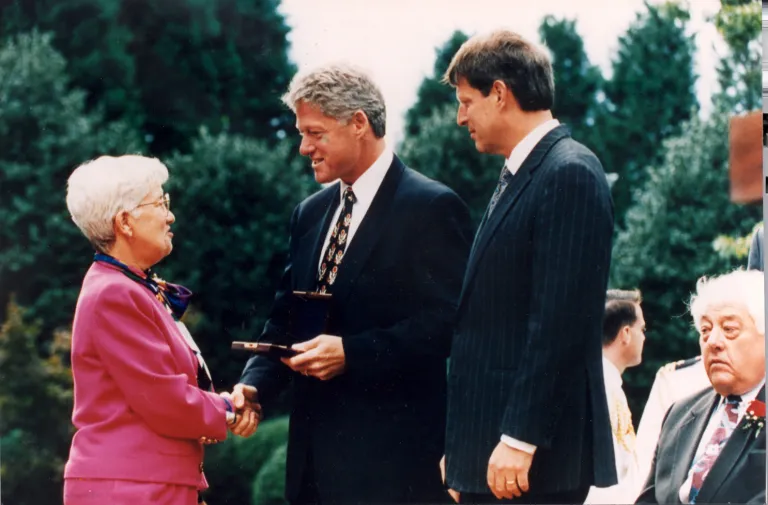
Holding the Door for Future Generations
Vera Rubin was a trailblazer in astronomy who refused to let any door stay closed to her, whether in science or society. So, it's fitting that one of the most commonly told stories about her involves the actual bathroom doors at Palomar Observatory.
At that time, the Palomar was one of the world’s most prestigious observatories. However, women had been historically barred from observing because there were no ladies' facilities.
In 1965, Rubin became the first woman officially invited to use the observatory. Yet when she arrived, the bathroom door still said "MEN." Taking the problem in hand, she found a pen and some tape, drew a figure wearing a skirt, and affixed it to the bathroom door, declaring, "There you go; now you have a ladies’ room."
The next time she observed at Palomar, the skirted woman was gone, and so was the sign for “MEN.”
One small moment of progress out of a lifetime of such moments, Rubin's bathroom edit highlights her resilience and humor in the face of the absurd everyday obstructions that women in science faced in 1965. It also reflects the larger changes around the nation. Just as the country was beginning to confront long-standing injustices, Rubin was busy breaking down barriers in her own field.
“Vera would stand up against injustice and prejudice whenever she could,” recalls Alycia Weinberger, a staff astronomer at Carnegie Science who worked alongside Rubin. “She was aggravated by how few women had won prizes from the American Astronomical Association and been elected to the National Academies. Every season, she would be busy in her office nominating women herself and exhorting others to do so.”
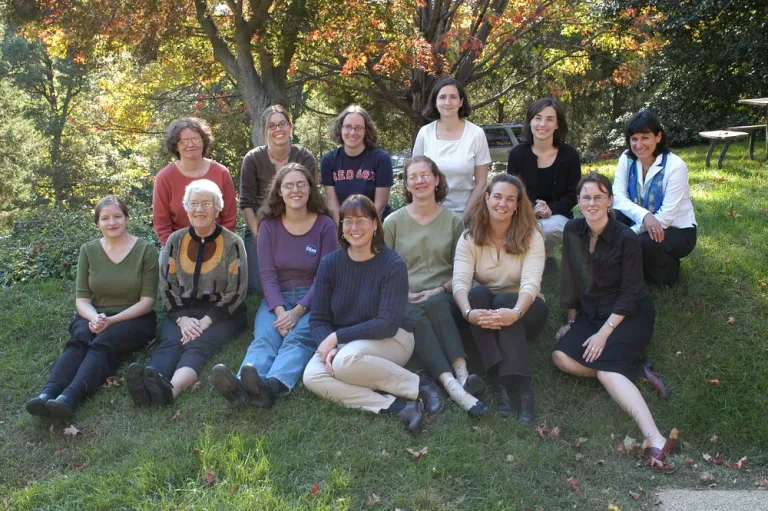
Front row left to right: Brooke Hunter, Vera Rubin, K.E. Saavik Ford, Alycia Weinberger, Mary Horan, Kathleen Flint, Alexis Clement. Back row left to right: Linda Warren, Alison Shaw, Katherine Kelley, Sara Seager, Lucy Flesch, Jan Dunlap.
Just as 1965 was a year of opening doors across the country, Vera Rubin spent her life opening doors for future generations, ensuring that no one would have to tape a paper skirt to a bathroom door again. She helped win inclusion at the Palomar Observatory, the exclusive Cosmos Club, and she even advised the Pope advocating for more women in the Pontifical Academy of Sciences.
Rubin passed away in 2016, but her legacy continues. Over her career, Rubin observed more than 200 galaxies, mentored generations of astronomers, and laid the groundwork for all of the dark matter research we do today. Her life is a powerful reminder that persistence can move even the toughest barriers and change the way we see the universe.
Keep Exploring
Oral Histories
- Vera Rubin's 1989 AIP Oral History Session with Alan Lightman
- Vera Rubin's 1995 AIP Oral History Session with David DeVorkin
- Vera Rubin's 1996 AIP Oral History Session with David DeVorkin
- Vera Rubin's 2007 AIP Oral History Session with David DeVorkin and Ashley Yeager
Memoirs
Bonus: Kent Ford's 2013 AIP Oral History Session with David DeVorkin and Shaun Hardy
- Bright Galaxies, Dark Matter, and Beyond: The Life of Astronomer Vera Rubin
by Ashley Jean Yeager (MIT Press, 2021)
“How Vera Rubin convinced the scientific community that dark matter might exist, persevering despite early dismissals of her work and widespread sexism in science.”
- Vera Rubin: a Life
by Jacqueline Mitton and Simon Miton (Harvard University Press, 2021)
“The first biography of a pioneering scientist who made significant contributions to our understanding of dark matter and championed the advancement of women in science.”
- The Stuff Between the Stars: How Vera Rubin Discovered Most of the Universe
by Sandra Nickeland (author) and Aimée Sicuro (illustrator) (Harry N. Abrams, 2021)
"A stunning portrait of a little-known trailblazer, The Stuff Between the Stars tells Vera’s story and inspires the youngest readers who are just starting to look up at the stars."
- Good Seeing: a Century of Science at the Carnegie Institution of Washington
by James Trefil; Margaret Hindle Hazen; Timothy Ferris (Joseph Henry Press, 2001)
"Good Seeing presents a readable, inspiring history of the Carnegie Institution of Washington, from its founding in 1902, through the emergence of "big science" after World War II, to the institution's role in addressing the major science questions of the 21st century."
1965 - First woman staff scientist at Carnegie’s Department of Terrestrial Magnetism
1965 - First woman allowed to observe at Palomar Observatory
1970s- With Kent Ford and colleagues, Rubin measured galaxy rotation curves that support the existence of dark matter
1981- Second woman astronomer elected to National Academy of Sciences
1993 - Received U.S.National Medal of Science
1996 - Second woman to receive Gold Medal of the Royal Astronomical Society
2001 - Donated personal papers to Library of Congress
2012 - American Physical Society designates BBR historic site for Rubin’s dark matter work with Kent Ford
2017- Mars area in Gale Crater dubbed the Vera Rubin Ridge
2020 - First U.S. observatory to be named after a woman when the Large Synoptic Survey Telescope is renamed Vera C.Rubin Observatory
-
Dark Matter Discoverer Vera Rubin Blazed New Trails for Women, Astronomy | Georgetown University
-
Remembering the Genius of Vera Rubin | Cosmos Quickly | Scientific American
-
Five Things to Know About Boundary-Breaking Astronomer Vera Rubin | Smithsonian Magazine
-
Vera Rubin’s son reflects on how she paved the way for women | NPR and PBS
Obituary: Vera Rubin Died on December 25th
THE ECONOMIST
"The American astronomer who established the existence of dark matter was 88."
From lab to Olympic podium to White House, accomplished women are still dismissed
THE WASHINGTON POST
"It’s pretty safe to say that 2016 was not the year of the woman."
Pioneering astronomer Vera Rubin dies at 88
SCIENCE AAAS
"Astronomer Vera Rubin once told Science’s Rob Irion that “I became an astronomer because of looking at the sky” from the window of her childhood bedroom in Washington, D.C. Rubin, who died Sunday at the age of 88, went on to have a long and distinguished career, including being awarded the National Medal of Science in 1993."
How Vera Rubin changed science
THE WASHINGTON POST
"Vera Rubin didn't plan to be a pioneering female astronomer. When she was 10, lying awake at her home in Washington, memorizing the paths of the stars outside her window, “I didn't know a single astronomer, male or female,” she once said in an interview. “I didn't think that all astronomers were male, because I didn't know.”
Pioneering astronomer Vera Rubin dies at 88; she helped find evidence of dark matter
LOS ANGELES TIMES
"As a woman, astrophysicist Vera Rubin had to fight just to get access to a telescope. What she saw when she did further rattled conventions: galaxies that were rotating more quickly than predicted by the laws of physics."
Remembering Vera Rubin
INSIDE SCIENCE
"Pioneering astronomer who discovered observational evidence of the existence of mysterious dark matter in the universe dies at 88."
Vera C Rubin 1928-2016
A & G FORUM
"Vera Rubin was born Vera Florence Cooper on 23 July 1928 in Philadelphia, the younger of two daughters of Philip and Rose Cooper."
Vera Cooper Rubin
PHYSICS TODAY
"Vera Cooper Rubin, who transformed our understanding of the universe by confirming the existence of dark matter, passed away on 25 December 2016 in Princeton, New Jersey. A trailblazing astronomer, a passionate champion of women in science, and an inspiring role model to generations of scientists, Rubin was loved and admired by her many colleagues and friends."
Vera Rubin: 1928–2016
SCIENTIFIC AMERICAN
"She was a vibrant role model for women in astronomy but was not defined by, nor will she be remembered for, her gender but rather by her remarkable contributions as a scientist."
Vera Rubin, Scientist Who Opened Doors for Physics and for Women, Dies at 88
THE NEW YORK TIMES
"Vera Rubin, who transformed modern physics and astronomy with her observations showing that galaxies and stars are immersed in the gravitational grip of vast clouds of dark matter, died on Sunday in Princeton, NJ, She was 88."
Vera Rubin (1928-2016)
NATURE
"Vera Cooper Rubin was a pioneering astronomer, an admired role model and a passionate champion of female scientists. Her groundbreaking work confirmed the existence of dark matter and demonstrated that galaxies are embedded in dark-matter halos, which we now know contain most of the mass in the Universe."
Vera Rubin, Who Confirmed Existence Of Dark Matter, Dies At 88
NATIONAL PUBLIC RADIO
"Vera Rubin, the groundbreaking astrophysicist who discovered evidence of dark matter, died Sunday night at the age of 88, the Carnegie Institution confirms."
2016 also took one of the greatest female scientists of all time
CNN
"Vera Rubin, a pioneering astrophysicist who proved the existence of dark matter, had a gift for overcoming daunting challenges."
Vale Vera Rubin, the greatest astronomer you never heard of
THE SYDNEY MORNING HERALD
"Over the last few years I started and abandoned many, many emails to the late, great Vera Rubin, mainly because they all seemed to simply be love letters to a pioneer of astrophysics."
Vera C. Rubin: Pioneering American Astronmer (1928-2016)
PROCEEDINGS OF THE NATIONAL ACADEMY OF SCIENCES OF THE UNITED STATES OF AMERICA
"Vera Cooper Rubin, an icon of astronomy whose work revolutionized our understanding of the universe by confirming the existence of dark matter, passed away on December 25, 2016 at the age of 88. Vera had a lifelong love of the cosmos."
Vera Rubin, astronomer who helped find evidence of dark matter, dies at 88
THE GUARDIAN
"Scientist from Philadelphia helped find powerful evidence of dark matter by discovering galaxies don’t quite rotate in the way they were predicted."
-
Vera Rubin's publications in the Astrophysics Data System (ADS)
-
The form of the Galactic Spiral Arms from a Modified Oort Theory, V. C. Rubin, Astron. J., 60, 177, 1955.
-
Solar Limb Darkening Determined from Eclipse Observations, V. C. Rubin, Astrophys. J., 129, 812, 1959.
-
Structure and Evolution of the Galactic System, V. C. Rubin, Physics Today, 13, 32 (December), 1960.
-
Faint Lines in the Arc Spectrum of Iron (Fe1), C. C. Kiess, V. C. Rubin, C. E. Moore, Washington: National Bureau of Standards, 1961.
-
Kinematic Studies of Early-Type Stars I. Photometric Survey, Space Motions, and Comparison with Radio Observations, V. C. Rubin, J. Burley, A. Kiasatpoor, B. Klock, G. Pease, E. Rutscheidt, and C. Smith, Astron. J., 67, 491, 1962.
-
The Interpretation of the K Term in the Radial Velocities of Cepheids and O and B Stars, V. C. Rubin, Astrophys. J., 138, 613, 1963.
-
Galactic Coordinates for Plate Centers of Palomar Sky Atlas, V. C. Rubin and M. F. McCarthy, S. J., Astrophys. J. Supp. No. 78, 213, 1963.
-
Classification of G Type Stars in the Near Ultraviolet Region, M. F. McCarthy, S. J., and V. C. Rubin, Specola Astronomica Vaticanag, Riceriche Astronomiche, Vol. 6, No. 19, 1963.
-
Detection of Abell's Faint Clusters on Ross-Calvert and Lick Sky Atlas Prints, M. F. McCarthy, S. J., and V. C. Rubin, Proc. Astron. Soc. Pac., 75, 197, 1963.
-
Kinematics of Early-Type Stars II. The Velocity Field within 2 kiloparsecs of the Sun, V. C. Rubin and J. Burley, Astron. J., 69, 92, 1964.
-
The Rotation and Mass of NGC 6503, E. M. Burbidge, G. R. Burbidge, D. J. Crampin, V. C. Rubin, and K. H. Prendergast, Astrophys. J., 139, 539, 1964.
-
The Rotation and Mass of NGC 3521, E. M. Burbidge, G. R. Burbidge, D. J. Crampin, V. C. Rubin, and K. H. Prendergast, Astrophys. J., 139, 1058-1065, 1964.
-
The Rotation and Mass of NGC 1792, V. C. Rubin, E. M. Burbidge, G. R. Burbidge, and K. H. Prendergast, Astrophys. J., 140, 80-84, 1964.
-
Motions in Barred Spirals VI. The Rotation and Velocity Field of NGC 613, E. M. Burbidge, G. R. Burbidge, V. C. Rubin, and K. H. Prendergast, Astrophys. J., 140, 85-93, 1964.
-
Motions in Barred Spirals, VII. The Velocity Field of NGC 925, V. C. Rubin, E. M. Burbidge, and G. R. Burbidge, Astrophys. J., 140, 94-98, 1964.
-
A Study of the Velocity Field in M82 and Its Bearing on Explosive Phenomena in that Galaxy, E. M. Burbidge, G. R. Burbidge, and V. C. Rubin, Astrophys. J., 140, 942-968, 1964.
-
NGC 2188, A Peculiar Southern Galaxy, V. C. Rubin, E. M. Burbidge, and G. R. Burbidge, Astrophys. J., 140, 1304, 1964.
-
The Rotation and Mass of NGC 7331, V. C. Rubin, E. M. Burbidge, G. R. Burbidge, D. J. Crampin, and K. H. Prendergast, Astrophys. J., 141, 759, 1965.
-
The Rotation and Mass of the Inner Parts of NGC 4826, V. C. Rubin, E. M. Burbidge, G. R. Burbidge, and K. Prendergast, Astrophys. J., 141, 885, 1965.
-
Radial Velocities of Distant O B Stars in the Anticenter Region of the Galaxy, V. C. Rubin, Astrophys. J., 142, Oct. 1965.
-
An Old Open Cluster Near the North Galactic Pole, A. R. Upgren and V. C. Rubin, P.A.S. P., Oct. 1965.
-
Low-dispersion Image-tube Spectra in the Red: 3C 33, 3C 48, Ton 256, and an Infrared Star, W. K. Ford, Jr., and V, C. Rubin, Astrophys. J., 142, 1303, 1965.
-
Quasi-stellar Objects with Small Redshifts: 1217+02, 3C 249.1, and 3C 263, W. K. Ford, Jr., and V. C. Rubin, Astrophys. J., 145, 357, 1966.
-
Faint Blue Objects in the Virgo Cluster Region, V. C. Rubin, Sandra Moore, and F. C. Bertiau, S. J., Astron. J., 72, 59, 1967.
-
Optical Observations of Radio Galaxies and Quasi-stellar Objects, V. C. Rubin, in High Energy Astrophysics, I., pp. 133-151, DeWitt, C., E. Schatzman, and P. Veron, eds., N. Y. Gordon and Breach, 1967.
-
The Spectrum of the 1967 Supernova in NGC 3389 and H-alpha Velocities in the Galaxy, V. C. Rubin and W. K. Ford, Jr., Publ. Astron. Soc. Pacific, 79, 322, 1967.
-
Radial Velocities from Image Tube Spectra, V C. Rubin, W. K. Ford, Jr., J. W. Christy, Inter. Astron. Union Symp. No. 30, 5, 1967.
-
Spectroscopic Study of the Seyfert Galaxy NGC 3227, V. C. Rubin and W. K. Ford, Jr., Astrophys. J., 154, 431, 1968.
-
Foil- and Gas-Excitation of Sodium Spectra, L. Brown, W. K. Ford, Jr., V. C. Rubin, W. Trachslim, and W. Brandt, in Beam-Foil Spectroscopy, I., pp. 45-77, S. Bashkin, ed., N. Y., Gordon and Breach, 1968.
-
Optical Spectra Near 1 Micron: the Seyfert Galaxy NGC 4151 and the Planetary Nebula NGC 6543, W. K. Ford, Jr., A. T. Purgathofer, and V. C. Rubin, Astrophys. J., 153, L39, 1968.
-
The Spectrum of the 1968 Supernova in NGC 2713, W. K. Ford, Jr., and V. C. Rubin, Publ. Astron. Soc. Pacific, 80, 466, 1968.
-
Observations of M82 in the Optical Infrared, F. Bertola, S. D'Odorico, W. K. Ford, Jr., and V. C. Rubin, Astrophys. J., 157g, L27, 1969.
-
A Note on the Systemic Velocity of M31, V. C. Rubin and S. D'Odorico, Astron. Astrophys., 2, 484, 1969.
-
A Comparison of Dynamical Models of the Andromeda Nebula and the Galaxy, V. C. Rubin and W. K. Ford, Jr., in Inter. Astron. Union Symp. No. 38, The Spiral Structure of Our Galaxy, pp. 61-68, W. Becker and G. Contopoulos, eds., Dordrecht, Holland, D. Reidel Publ. Co., 1970.
-
Rotation of the Andromeda Nebula from a Spectroscopic Survey of Emission Regions, V. C. Rubin and W. K. Ford, Jr., Astrophys. J., 159, 379, 1970.
-
Emission-line Intensities and Radial Velocities in the Interacting Galaxies NGC 4038-4039, V. C. Rubin, W. K. Ford, Jr., and S. D'Odorico, Astrophys. J., 160, 801, 1970.
-
Narrow Band Filter Photographs and Spectra of the Planetary Nebula NGC 7009, W. K. Ford, Jr., and V. C. Rubin, Astrophys. Lett., 8, 67, 1971.
-
A Comparison of 21-CM Radial Velocities and Optical Radial Velocities of Galaxies, W. K. Ford, Jr., V C. Rubin, and M. S. Roberts, Astron. J., 76, 22, 87, 1971.
-
Radial Velocities and Line Strengths of Emissions Lines Across the Nuclear Disk of M31, V. C. Rubin and W. K. Ford, Jr., Astrophys. J., 170, 25, 1971.
-
A Finding List of Faint Blue Stars in the Anticenter Region of the Galaxy, V. C. Rubin and J. M. Losee, Astron. J., 76, 1099, 1971.
-
Gas in the Nucleus and Disk of M31, V C. Rubin and W. K. Ford, Jr., in Intern. Astron. Union Symp. 44, External Galaxies and Quasi-stellar Objects, pp. 49-55, D. S. Evans, ed., Dordrecht, Holland, D. Reidel Publ. Co., 1972.
-
Variation of Emission-line Strengths Across M31, V. C. Rubin, C. K. Kumar, and W. K. Ford, Jr., Astrophys. J., 177, 31, 1972.
-
The Dynamics of the Andromeda Nebula, V C. Rubin, Scientific American, 228, 30, 1973.
-
Early Observations of the Crab Nebula as a Nebula, V. C. Rubin, R. J. Rubin, Bull. Am. Astron. Soc., 5, 411, 1973.
-
Stellar Motions Near the Nucleus of M31, V. C. Rubin, W. K. Ford, Jr., and C. K. Kumar, Astrophys. J., 181, 61, 1973.
-
Line Intensities and Radial Velocities for 12 Planetary Nebulae, S. D'Odorico, V. C. Rubin, and W. K. Ford, Jr., Astron. Astrophys., 22, 469, 1973.
-
Astronomy Spoken Here, V. C. Rubin, in Language and International Studies, K. R. Jankowsky, ed., Washington, D. C., Georgetown Univ. School of Languages and Linguistics, pp. 139-143, 1973.
-
A Curious Distribution of Radial Velocities of ScI Galaxies with 14.0 m 15.0, V. C. Rubin, W. K. Ford, Jr., and J. S. Rubin, Astrophys. J., 183, L111, 1973.
-
Klemola 30: A Group of Interconnected Galaxies, J. A. Graham, and V. C. Rubin, Astrophys. J., 183, 19, 1973.
-
Two Chains of Interesting Southern Galaxy: NGC 7172-73-74-76 and NGC 7201-03-04, V. C. Rubin, Astrophys. J., 191, 645, 1974.
-
Second Finding List of Faint Blue Stars in the Anticenter Region of the Galaxy, V. C. Rubin, D. Westpfahl, Jr., and M. A. Tuve, Astron. J., 79, 1409, 1974.
-
Report to the Council of the AAS from the Working Group on the Status of Women in Astronomy, A. Cowley, R. Humphreys, B. Lynds, and V. Rubin, Bull. Amer. Astron. Soc., 6, 412, 1974.
-
Physical Conditions and Structure in NGC 7293, J. W. Warner, and V. C. Rubin, Astrophys. J., 198, 593, 1975.
-
Observations of NGC 6764, A Barred Seyfert Galaxy, V. C. Rubin, N. Thonnard, and W. K. Ford, Jr., Astrophys. J., 199, 31, 1975.
-
Evidence for Contraction in the Nuclear Ring of Barred Spiral Galaxy NGC 3351, V. C. Rubin, W. K. Ford, Jr., and C. J. Peterson, Astrophys. J., 199, 39, 1975.
-
Institutional Arrangements for the Space Telescope, V. C. Rubin plus 16 other authors, National Academy of Sciences, 1976.
-
Motions of the Excited Gas in the Barred Spiral Galaxy NGC 3351, C. J. Peterson, V. C. Rubin, W. K. Ford, Jr., and N. Thonnard, Astrophys. J., 208, 662, 1976.
-
Motion of the Galaxy and the Local Group Determined from the Velocity
-
Anisotropy of Distant ScI Galaxies I. The Data, V. C. Rubin, W. K. Ford, Jr., N. Thonnard, M. S. Roberts, and J. A. Graham, Astron. J., 81, 687, 1976.
-
Motion of the Galaxy and the Local Group of Galaxies Determined from the Velocity Anisotropy of Distant ScI Galaxies II. The analysis for the Motion, V. C. Rubin, W. K. Ford, Jr., N. Thonnard, and M. S. Roberts, Astron. J., 81, 719, 1976.
-
Spectra of Three Type I Supernovae, G. E. Assousa, C. J. Peterson, V. C. Rubin, and W. K. Ford, Jr., Publ. Astron. Soc. Pac., 88, 828, 1976.
-
New Observations of the NGC 1275 Phenomenon, V. C. Rubin, W. K. Ford, Jr., and J. H. Oort, Astrophys. J., 211, 697, 1977.
-
Position Angle of the Major Axis of the Nuclear Region of M31, C. J. Peterson, W. K. Ford, Jr., and V. C. Rubin, Astron. J., 82, 32-34, 1977.
-
The Scatter on the Hubble Diagram and the Motion of the Local Group, V. C. Rubin, Astrophys. J. Letters, 211, L1, 1977.
-
The Anisotropy of ScI Galaxy Velocities Interpreted as a Motion of our Galaxy and the Local Group of Galaxies, V. C. Rubin, Royal Greenwich Obs. Bull., 182, 183, 1976.
-
Is There Evidence for Anisotropy in the Expansion of the Universe?, V. C. Rubin, in I.A.U. Coll. #37, Decalages Vers le Rouge et Expansion de L'Univers, CNRS, Paris, 1977.
-
Is There Evidence for Anisotropy in the Hubble Expansion?, V. C. Rubin, Eighth Texas Symposium on Relativistic Astrophysics, M. D. Papagiannis, ed., Annals of the New York Academy of Sciences, 302, 408-421, 1977. 10.1111/j.1749-6632.1977.tb37062.x.
-
The Velocity Field of the Barred Spiral Galaxy NGC 5383, C. J. Peterson, V. C. Rubin, and W. K. Ford, Jr., Astrophys. J., 219, 31, 1978.
-
Extended Rotation Curves of High Luminosity Spiral Galaxies: I. The Angle Between Axis of the Nucleus and the Outer Disk of NGC 3672, V. C. Rubin, N. Thonnard, and W. K. Ford, Jr., Astrophys. J. Lett., 1977.
-
The Compact Blue-shifted Galaxy RMB 56 (1216+141), T. D. Kinman, V. C. Rubin, W. K. Ford, Jr., and C. J. Peterson, Astrophys. J., 82, 879, 1977.
-
A New Mapping of the Velocity Field of NGC 1275, V. C. Rubin, W. K. Ford, Jr., C. J. Peterson, and C. R. Lynds, Astrophys. J. Suppl., 37, 235, 1978.
-
Extended Rotation Curves of High Luminosity Spiral Galaxies. II. The Anemic Spiral Galaxy NGC 4378, V. C. Rubin, W. K. Ford, Jr., K. M. Strom, S. E. Strom, and W. Romanishin, Astrophys. J., 244, 782, 1978.
-
NGC 5506: An X-ray Seyfert Galaxy, V. C. Rubin, Astrophys. J. Lett., 224, L55, 1978.
-
Extended Rotation Curves of High-Luminosity Spiral Galaxies, III. NGC 7212, C. J. Peterson, V. C. Rubin, W. K. Ford, Jr., and M. S. Roberts, Astrophys. J., 266, 770, 1978.
-
Extended Rotation Curves of High-Luminosity Spiral Galaxies, IV. Systematic Dynamical Properties Sa-Sc, V. C. Rubin, W. K. Ford, Jr., and N. Thonnard, Astrophys. J. Lett., 225, L107, 1978.
-
Radial Velocities of Spiral Galaxies Determined from 21-cm Hydrogen Observations, N. Thonnard, V. C. Rubin, W. K. Ford, Jr., M. S. Roberts, Astron. J., 83, 1564, 1978.
-
Redshifts, in Trans. of the Intern. Astron. Union, Reports of Astronomy, Pt. 3, XVIIA, pp. 211-220, W. B. Burton, ed., D. Reidel Publ. Co., Dortrecht, Holland, 1979.
-
Rotation Curves of High Luminosity Spiral Galaxies and the Rotation Curve of Our Galaxy, V. C. Rubin, I.A.U. Symposium #84, The Large Scale Characteristics of the Galaxy, D. Reidel Publ. Co., Dortrecht, Holland, p. 211, 1979.
-
Extended Optical Rotation Curves of Spiral Galaxies, Comments on Astrophysics, 8, 79, 1979.
-
Extended Rotation Curves of High-Luminosity Spiral Galaxies, V. NGC 1961, The Most Massive Spiral Known, V. C. Rubin, W. K. Ford, Jr., and M. S. Roberts, Astrophys. J., 230, 35, 1979.
-
Galactic Dynamics, Berkhuijsen, E. M., Einasto, J., V. Rubin, Science, 203, 43, 1979. [Book Reviews: Structure and Properties of Nearby Galaxies. Papers from a symposium, Bad Munstereifel, Germany, Aug. 1977, The Large Scale Structure of the Universe. Papers from a symposium, Tallinn, Estonia, USSR, Sept. 1977.]
-
Rotational Properties of 21 Sc Galaxies with a Large Range of Luminosities and Radii, from NGC 4605 (R = 4 kpc) to UGC 2885 (R = 122 kpc), V. C. Rubin, W. K. Ford, Jr., and N. Thonnard, Astrophys. J., 238, 471, 1980. [This paper ranked first as the most cited paper of all those based on observations with the 4 large US telescopes, 1980-1981, H. Abt, Publ. Ast. Soc. Pac., 87, 1050, 1985.]
-
Velocities and Mass Distribution in the Barred Spiral NGC 5728, V. C. Rubin, Astrophys. J., 238, 808, 1980.
-
Book Review – The Sky Explored – Celestial Cartography – 1500-1800, D. J. Warner and V. Rubin, Science, 210, 633, 1980.
-
Rotation and Mass of the Inner 5 Kiloparsecs of the SO Galaxy, NGC 3115, V. C. Rubin, C. J. Peterson, and W. K. Ford, Jr., Astrophys. J., 239, 50, 1980.
-
UGC 2885, The Largest Known Spiral, V. C. Rubin, MERCURY, Astron. Soc. Pacific, 9, 78, 1980.
-
Stars, Galaxies, Cosmos: The Past Decade, The Next Decade, V. C. Rubin, Science, 209, 64, 1980, reprinted in The Science Centennial Review, P. H. Abelson, and R. Kulstad, eds., A.A.A.S., Washington, D.C., 1980.
-
Galactic Go-around, V. C. Rubin, Natural History, 89, 80, August 1980.
-
Kinematics of Nuclei of Galaxies, V. C. Rubin, in Highlights of Astronomy, Vol. 5, p. 191, Reidel Publ. Co., Dortrecht, Holland, 1980.
-
A New Relation for Estimating the Intrinsic Luminosities of Spiral Galaxies, V. C. Rubin, D. Burstein, and N. Thonnard, Astrophys. J. Letter, 242, L149, 1980.
-
E. Margaret Burbidge, President Elect, V. C. Rubin, Science, 211, 915, 1981.
-
Comparative Dynamics of Sa, Sb, and Sc Galaxies, V. C. Rubin, in The Comparative HI Content of Normal Galaxies (proceedings of workshop, April 5-8, 1982) pp. 42-45, National Radio Astronomy Observatory, Green Bank, West Virginia, 1982.
-
NGC 3067: Additional Evidence for Nonluminous Matter?, V. C. Rubin, N. Thonnard, and W. K. Ford, Jr., Astron. J., 87, 477, 1982.
-
Redshifts, in Reports on Astronomy 1982, (XVIIIth General Assembly of the IAU, Patras, Greece), pp. 322-326, Patrick A. Wayman, ed., D. Reidel Publ. Co., Dordrecht, Holland, 1982.
-
The Distribution of Mass in Sc Galaxies, D. Burstein, V. C. Rubin, N. Thonnard, and W. K. Ford, Jr., Astrophys. J., 253, 70, 1982.
-
Rotational Properties of 23 Sb Galaxies, V. C. Rubin, W. K. Ford, Jr., N. Thonnard and D. Burstein, Astrophys. J., 261, 439, 1982.
-
Male World of Physics?, V. C. Rubin, Physics Today (Letters), 35, 121, 1982.
-
Priest Identified, V. C. Rubin, Physics Today (Letters), 35, 109, 1982.
-
Book Review: A Revised Shapley-Ames Catalog of Bright Galaxies, A. Sandage, G. A. Tammann, and V. C. Rubin, Sky and Telescope, 63, 478, 1982.
-
Dark Matter in Spiral Galaxies, V. C. Rubin, Sci. Amer., 248, 96, 1983, reprinted in The Universe of Galaxies, P. W. Hodge, ed., Freeman, New York, 1984.
-
NGC 3200: Is This What Our Galaxy is Like?, V. C. Rubin, in Kinematics, Dynamics and Structure of the Milky Way, pp. 379-384, W. L. H. Shuter, ed., Reidel Publ. Co., Dordrecht, Holland, 1983. [Proceedings of the Workshop on the Milky Way, Vancouver, British Columbia, 1982.]
-
The Rotation of Spiral Galaxies, V. C. Rubin, Science, 220, 1339, 1983.
-
Systematics of HII Rotation Curves, V. C. Rubin, in Internal Kinematics and Dynamics of Galaxies, (IAU Symp. 100, Besancon, France, August 9-13, 1982)g, pp. 3-10, E. Athanassoula, ed., D. Reidel Publ. Co., Dordrecht, Holland, 1983.
-
The Noninteracting Spiral Pair, NGC 450/UGC 807, V. C. Rubin and W. K. Ford, Jr., Astrophys. J., 271, 556, 1983.
-
A New Method for Evaluating the Hubble Constant, V. C. Rubin and N. Thonnard, in Highlights of Astronomy, Vol.6, p. 288, Richard M. West, ed., D. Reidel Publ. Co., Dordrecht, Holland, 1983.
-
Hubble-type Dependence in the Tully-Fisher Relationship, N. Thonnard and V. C. Rubin, in Highlights of Astronomy, Vol. 6, p. 287, Richard M. West, ed., D. Reidel Publ. Co., Dortrecht, Holland, 1983.
-
Colliding and Merging Galaxies. II. SO Galaxies with Polar Rings, F. Schweizer, B. C. Whitmore, and V. C. Rubin, Astron. J., 88, 909, 1983.
-
-
-
Luminosity-Dependent Line Ratios in Disks of Spiral Galaxies, V. C. Rubin, W. K. Ford, Jr., and B. C. Whitmore, Astrophys. J., 281, L21, 1984.
-
Stellar and Gas Kinematics in Disk Galaxies, B. C. Whitmore, V. C. Rubin, and W. K. Ford, Jr., Astrophys. J., 287, 66, 1984.
-
Evidence for Dark Halos Around Spiral Galaxies, V. C. Rubin, in The Proceedings of the First ESO-CERN Symposium, (Geneva, November 21-25, 1983), G. Setti and L. Van Hove, eds., pp. 204-205, ESO and CERN, Geneva, Switzerland, 1984.
-
Galaxy Formation and Cosmology – Short Contributions, V. C. Rubin. Proceedings of the 1st ESO/CERN Symposium held 21-25 November 1983 at CERN, Geneva, G. Setti and L. Van Hove, eds. Garching: European Southern Observatory (ESO), 1984, p. 204.
-
Rotation Velocities of 16 Sa Galaxies and a Comparison of Sa, Sb and Sc Rotation Properties, V. C. Rubin, D. Burstein, W. K. Ford, Jr., and N. Thonnard, Astrophys. J., 289, 81, 1985.
-
The Distribution of Mass in Spiral Galaxies, D. Burstein and V. C. Rubin, Astrophys. J., 297, 423, 1985.
-
A Convergence of Lives, Sofia Kovalevskaia: Scientist, Writer, Revolutionary. A book essay, V. C. Rubin and L. L. Stryker, The Mathematical Intelligencer, 7, No. 4, 69, 1985.
-
Report of IAU Commission 28: Galaxies, V. C. Rubin, Trans. Int. Astron. Union (Reports on Astronomy), 19A, 313-352, 1985.
-
The Hubble Expansion and the Motion of the Galaxy, V. C. Rubin, in Gamow Cosmology, "Enrico Fermi," F. Melchiorri and R. Ruffini, eds., pp. 160-167, North-Holland Physics Publ., The Netherlands, 1986.
-
Spiral Galaxy Dynamics and the Mass of the Universe, V. C. Rubin, in Gamow Cosmology, "Enrico Fermi", F. Melchiorri and R. Ruffini, eds., pp. 148-159, North-Holland Physics Publ., The Netherlands, 1986.
-
Is the Distribution of Mass within Spiral Galaxies a Function of Galaxy Environment?, D. Burstein, V. C. Rubin, W. K. Ford, Jr., and B. C. Whitmore, Astrophys. J., 305, L11, 1986.
-
GC 12591: The Most Rapidly Rotating Disk Galaxy, R. Giovanelli, M. P. Haynes, V. C. Rubin, and W. K. Ford, Jr., Astrophys. J., 301, L7, 1986.
-
Optical Rotation Velocities and Images of the Spiral Galaxy NGC 3198, D. A. Hunter, V. C. Rubin, and J. S. Gallagher III, Astron. J., 1, 1086, 1986.
-
Dark Matter in the Universe, in Highlights of Astronomy, V. C. Rubin, Vol. 19, J. P. Swings, ed., pp. 27-38, D. Reidel Publ. Co., Dordrecht, Holland, 1986.
-
What's the Matter in Spiral Galaxies?, V. C. Rubin in Highlights of Modern Astrophysics: Concepts and Controversies, (symposium held in honor of Ed Salpeter), S. L. Shapiro and S. A. Teukolsky, eds., John Wiley & Sons, Inc., New York, N. Y., pp. 269-297, 1986.
-
Women's Work: for Women in Science, a Fair Shake is Still Elusive, V. C. Rubin, Science, 86, 7, 58, 1986.
-
On the Ratio [NII]/Ha in the Nucleus of M33 and in the Nuclei of other Galaxies, V. C.
-
Rubin, and W. K. Ford, Jr., Astrophys. J. Letters, 305, pp. L35, 1986.
-
Evidence for a Central Massive Component in Late Type Spirals, V. C. Rubin, and J. A. Graham, Astrophys. J. Letters, 316, L67, 1987.
-
Difference in Mass Distribution for Field and Cluster Spiral Galaxies, D. D. Burstein and V. C. Rubin, in Dark Matter in the Universe, J. Knapp and J. Kormendy, eds., D. Reidel Publ. Co., Dordrecht, Holland, 66, 1987.
-
Constraints on the Dark Matter from Optical Rotation Curves, V. C. Rubin, D. Reidel Publ. Co., Dordrecht, Holland, 51-65, 1987.
-
Distribution of Dark Matter in Polar-ring Galaxies, B. C. Whitmore, D. B. McElroy, F. Schweizer and V. C. Rubin in Dark Matter in the Universe, J. Knapp and J. Kormendy, eds., D. Reidel Publ. Co., Dordrecht, Holland, 315, 1987.
-
Coherent Large-scale Motions from a New Sample of Spiral Galaxies, V. C. Rubin, in Large Scale Structure of the Universe, I.A.U. Symposium #130, 181, 1987.
-
Activity in Near Normal Galaxies, V. C. Rubin, in Observational Evidence of Activity in Galaxies, I.A.U. Symposium #121, 461, 1987.
-
Some Surprises in the Dynamics of M33 and M31, V. C. Rubin in The Outer Galaxy, L. Blitz and F. J. Lockman, eds., Springer-Verlag, New York, 247, 1988.
-
Dark Matter in the Universe, V. C. Rubin, Proc. American Phil. Soc. 132, 434--443, 1988.
-
To L. F. from V. C. R., in Philosophy, History and Social Action: Essays in Honor of Lewis Feuer, S. Hook, W. L. O'Neill, and R. O'Toole, eds., Kluwer Academic Publishers, Dordrecht, Holland, p. 391, 1988.
-
The Morphology of the Ionized Gas in M31's Bulge, R. Ciardullo, V. C. Rubin, G. H. Jacoby, H. C. Ford, and W. K. Ford, Jr., Astron. J., 95, 438, 1988.
-
Molecular and Ionized Gas in the Peculiar Galaxy NGC 2146, J. S. Young, M. J. Claussen, S. G. Kleinmann, V. C. Rubin, and N. Scoville, Astrophys. J. Letters, 331, L81, 1988.
-
Rotation Curves for Spiral Galaxies in Clusters. I. Data, Global Properties, and a Comparison with Field Galaxies, V. C. Rubin, B. C. Whitmore, and W. Kent Ford, Jr., Astrophys. J., 333, 522, 1988.
-
II. Variations as a Function of Cluster Position, B. C. Whitmore, D. A. Forbes, and V. C. Rubin, Astrophys. J., 333, 542, 1988.
-
Large-Scale Motions in the Universe: A Vatican Study Week, V. C. Rubin and G. V. Coyne, S.J., eds., Princeton University Press, 1988.
-
Large-Scale Motions from a New Sample of Spiral Galaxies: Field and Cluster, V. C. Rubin, in Large-Scale Motions in the Universe, V. C. Rubin and G. V. Coyne, eds., Princeton University Press, pp. 187-196, 1988.
-
Field and Cluster Galaxies: Do they Differ Dynamically? V. C. Rubin, in Large-Scale Motions in the Universe, V. C. Rubin and G. V. Coyne, eds., Princeton University Press, pp. 541-558, 1988.
-
Cluster Credit: Who Seconded the Motion?, D. H. Gudehus and V. C. Rubin, Physics Today, 41, 150, 1988.
-
The First Spectrum of M31, V. C. Rubin, Sky and Telescope, 75, 350, 1988.
-
Women Astronomers in the USSR, V. C. Rubin, A. G. Massevitch, and A. K. Terentjeva, Bull. Am. Astron. Soc., 20, 984, 1988.
-
A Comparison of Optical and VLA Rotation Curves for Virgo Spirals, V. C. Rubin, J. D. Kenney, A. P. Boss, and W. K. Ford, Jr., Astron. J., 98, 1246-1252, 1989.
-
The Local Supercluster and Anisotropy of the Redshifts, V. C. Rubin, in The World of Galaxies: Proceedings of a Symposium Le Monde des Galaxies, in honor of Gerard and Antoinette de Vaucouleurs on the occasion of his seventieth birthday, H. G. Corwin, Jr. and L. Bottinelli, eds., pp. 431-452, Springer-Verlag New York, Inc., 1989.
-
The Local Supercluster, V. C. Rubin, in Gerard and Antoinette de Vaucouleurs: A Life for Astronomy, M. Capaccioli and H. Corwin, eds., pp. 215-236, World Scientific, Singapore, 1989.
-
Weighing the Universe: Dark Matter and Missing Mass, V. C. Rubin, in Bubbles, Voids, and Bumps in Time, J. Cornell, ed., pp. 73-104, Cambridge University Press, Princeton, N.J., 1989.
-
Evidence for a Triaxial Bulge in the Spiral Galaxy NGC 4845, F. Bertola, V. C. Rubin, and W. W. Zeilinger, Astrophys. J. (Lett.), 345, L29-32, 1989.
-
The Triaxial Bulge in NGC 4845 as indicated by the Velocity Field and Isophotal Twisting, F. Bertola, V. C. Rubin, and W. W. Zeilinger, in ESO/CTIO Workshop on Bulges of Galaxies, eds. B. J. Jarvis and D. M. Terndrup, pp. 281-284, ESO, Munich, 1989.
-
Morphology and Dynamics of Galaxies in the Hickson Compact Groups, V. C. Rubin, W. K. Ford, Jr., and D. Hunter, in Evolution of the Universe of Galaxies, R. G. Kron, ed., pp. 30-32, Astronomical Society of the Pacific, San Francisco, 1990.
-
High Velocity Gas Drizzle into the Disk of NGC 4258, V. C. Rubin, and J. A. Graham, Astrophys. J. (Lett.), 362, L5-L8, 1990.
-
One Galaxy from Several: The Hickson Compact Group H31, V. C. Rubin, D. A. Hunter, and W. K. Ford, Jr., Astrophys. J., 365, 86-92, 1990.
-
Memories of the First Texas Symposium, E. A. Spiegel, V. C. Rubin, and J. L. Greenstein, Physics Today, 43, 118, 1990.
-
Optical Properties and Dynamics of Galaxies in the Hickson Compact Groups, V. C. Rubin, D. A. Hunter, and W. K. Ford, Jr., Astrophys. J. Supp., 76, 153-183, 1991.
-
Evidence for Dark Matter from Rotation Curves: Ten Years Later, V. C. Rubin, in After the First Three Minutes, AIP Conf. Proc. 22, eds. S. S. Holt, C. L. Bennett, and V. Trimble, 371, 1991.
-
Two Generations of Astrophysicists Look at the Problem of Opening the Doors for Women In Science, V. C. Rubin, in Recruiting and Retaining Women in Physics, Extracted in Physics Today, 45, 38, Aug. 1992.
-
Virgo Cluster Galaxies with Rapidly Rotating Disks, V. C. Rubin and J. D. P. Kenney, Bull. Am. Astron. Soc., 23, 1339, (Abstract), 1992.
-
Cospatial Counterrotating Stellar Disks in the Virgo E7/S0 Galaxy NGC 4550, V. C. Rubin, J. A. Graham, and J. P. D. Kenney, Astrophys. J. (Lett.), 394, L9-L12, 1992.
-
Herbig-Haro Objects in the Receding Lobe of the L1550 Outflow, J. A. Graham and V. C. Rubin, Publ. Astron. Soc. Pacific, 104, 104, 1992.
-
Women in Astronomy: A Sampler of Issues and Ideas, N. Barlow, F. A. Cordova, J. Bahcall, J. Price, K. Eastwood, N. Bahcall, G. Clayton, J. Lutz, J. Bell Burnell, D. Hunter, and 6 coauthors, Mercury, 21, 27-36, 1992.
-
Galaxy Dynamics and the Mass Density of the Universe, in Physical Cosmology, ed. D. Schramm, Proc. Nat. Acad. Sci., 90, 4814, 1993.
-
NGC 4550: A Two-Way Galaxy, V. C. Rubin, Mercury, XXII, 109, 1993.
-
First Person Astronomy – NGC 4550 – A Two-way Galaxy, V. C. Rubin, Astr. Soc. Pacific. Mercury, 22, 109, 1993.
-
Kinematics of NGC 4826: A Sleeping Beauty Galaxy, not An Evil Eye, V. C. Rubin, Astron. J., 107, 173, 1994.
-
Multi-Spin Galaxies, V. C. Rubin, Astron. J., 108, 456, 1994.
-
Reminiscences: Observing at the National Facilities, in A Look at AURA, 1994.
-
Gas Filaments in the Collisional Debris of NGC 4438, J.D.P. Kenney, V. C. Rubin, P. Planesas, and J. S. Young, Astrophys. J., 438, 135, 1995.
-
A Century of Galaxy Spectroscopy, V. C. Rubin, Astrophys. J., 451, 419, 1995.
-
Heldere sterrenstelsels en donkere materie (in Dutch), Zenit, Sept. 366, 1995.
-
Near-Nuclear Velocities in NGC 5907: Observations and Mass Models, B. W. Miller and V. C. Rubin, Astron, J., 110, 2692, 1995.
-
Kinematic Data for O-B5 Stars (Rubin +, 1962), V. C. Rubin, J. Burley, A. Kiasatpoor, B.Kock, G. Pease, E. Rutschedit, C. Smith, VizieR On-line Data Catalog: V/31A. Originally published in 1962 Astron. J., 67, 491,1995.
-
Evidence for a Merger in the Peculiar Virgo Cluster Sa Galaxy NGC 4424. J.D.P. Kenney, R. A. Koopmann, V. C. Rubin, and J. S. Young, Astron. J., 111, 152, 1996.
-
The Celestial Map, V. C. Rubin, for permanent display at the Einstein Statue, National Academy of Sciences, Washington D.C., April 1996.
-
Rubin, V. C., Happy Birthday Donald: Remarks After Dinner, in Gravitational Dynamics, ed. O. Lahav, E. Terlevich, and R. J. Terlevich (Cambridge University Press), 245, 1996.
-
Bright Galaxies, Dark Matters (a book), V. C. Rubin, Masters of Modern Physics Series, Springer-Verlag/AIP Press, New York, 1997.
-
Book Review: Bright Galaxies, Dark Matters/AIP, 1997, V. C. Rubin, The Observatory, 117, 311, 1997.
-
Rapidly Rotating Central Gas Disks in Virgo Disk Galaxies, V. C. Rubin, J.D.P. Kenney, and J. S. Young, Astron. J., 113, 1250, 1997.
-
From an Observer, V. C. Rubin, in Critical Dialogues in Cosmology, Proceedings of a Conference held at Princeton, New Jersey, 24-27 June 1996, Singapore: World Scientific, edited by Neil Turok, 597, 1997.
-
One Hundred Years of Galaxy Spectroscopy: On the Acceptance of the Gold Medal of the Royal Astronomical Society, The Observatory, 1997.
-
Eulogy: Robert Herman, Modern Astronomy, 1, 21, 1997.
-
What George Gamow Did Not Know About the Universe, in George Gamow Symposium, ed. E. Harper, D. Parke, D. Anderson, Conference Series 129, Astron. Soc. of the Pacific, San Francisco, 95, 1997.
-
Panel Discussion and Reminiscences of George Gamow, I. Gamow, M. Nirenberg, J. Follin, V. Rubin, A. Rich, R. Alpher, R. Herman, P. Abelson, in George Gamow Symposium, ed. E. Harper, D. Parke, D. Anderson, Conference Series 129, Astron. Soc. of the Pacific, San Francisco, 127, 1997.
-
Rotation Velocities of 90 Virgo Disk Galaxies, V. C. Rubin, A. H. Waterman, J. D. P. Kenney, American Astronomical Society, 191st AAS Meeting, Bull. Am. Astron. Soc., 29, 1379, 1997.
-
Dark Matter in the Universe, Scientific American Presents (special quarterly issue: Magnificent Cosmos) 9, 106, 1998.
-
Recollections after Fifty Years: Haverford AAS Meeting, December 1950, in The American Astronomical Society's First Century, ed. D. DeVorkin, V. C. Rubin, (AIP Press), pp. 90-93, 1999.
-
Kinematic Disturbances in Optical Rotation Curves among 89 Virgo Disk Galaxies, V. C. Rubin, A. W. Waterman, and J. P. D. Kenney, Astronom. J., 118, 236-260, 1999.
-
The Trials and Triumphs of American Women in Science, AWIS Magazine (Association for Women in Science) 28 (no. 2), 34-36, 1999.
-
Commentary on "A Correlation Between the Spectroscopic and Dynamical Characteristics of the Late F- and Early G-Type Stars" by Nancy G. Roman, Astrophys. J., 112, 554, 1950, V. C. Rubin, Astrophys. J., 525 (Centennial Issue) 401, 1999.
-
Roman’s Correlation Between Spectra and Motions of Intermediate-Type Stars, V. C. Rubin, Astrophys. J., Centennial Issue, 525C, 401, 1999.
-
One Hundred Years of Rotating Galaxies, V. C. Rubin, Publ. Ast. Soc. Pacific, 112, 747, 2000.
-
What We Cannot See and Yet Know Must Be There, V. C. Rubin, reprinted from Scientific American Presents, (Special Quarterly Issue: Magnificent Cosmos), in The Book of the Cosmos: Imagining the Universe from Heraclitus to Hawking, D. R. Danielson, ed., Helix Books/Perseus Publishing, Cambridge, Mass. 2000.
-
Imaging the Universe, V. C. Rubin, in Pontifical Academy of Sciences Proceedings, Nov. 2000.
-
Disturbed Kinematics in Virgo Cluster Spirals, V. C. Rubin, and J. Haltiwanger, in Disk Galaxies and Galaxy Disks, ed. J. G. Funes, S.J. and E. M. Corsini 2001, ASP Conference Series, 230, 421, 2001.
-
Rotation Curves of Spiral Galaxies, Y. Sofue and V. C. Rubin, Annual Review of Astron. and Astrophys., 39, 137, 2001.
-
Mass Density Profiles of Low Surface Brightness Galaxies, W. J. G. de Blok, S. McGaugh, A. Bosma, and V. C. Rubin, Astrophys. J. Letts., 552, L23, 2001.
-
High-Resolution Rotation Curves of Low Surface Brightness Galaxies: I. Data, S. McGaugh, V. C. Rubin, and W. J. G. de Blok, Astron. J., 122, 2381, 2001.
-
High-Resolution Rotation Curves of Low Surface Brightness Galaxies: II. Mass Models, W. J. G. de Blok, S. McGaugh, and V. C. Rubin, Astron. J., 122, 2396, 2001.
-
Why Study Nearby Galaxies?, V. C. Rubin, American Astronomical Society, 199th AAS Meeting, #02.01, Bull. Am. Astron. Soc., 33, 1303, 2001.
-
Why does an Optical Astronomer Study Something She Cannot See?, V. C. Rubin, in Beyond Earth: Mapping the Universe, D. DeVorkin, ed., pp. 186-203, National Geographic Society, Washington, DC, 2002.
-
The Stellar and Gas Kinematics of Several Irregular Galaxies, D. A. Hunter, V. C. Rubin, R. A. Swaters, L. S. Sparke, and S. E. Levine, Astrophys. J., 580, 194, 2002.
-
Stellar Motions in the Polar Ring Galaxy NGC 4650A, R. A. Swaters, and V. C. Rubin, Astrophys. J. (Lett.), 587, L23-L26, 2003.
-
A Brief History of Dark Matter, V. C. Rubin, in The Dark Universe: Matter, Energy, and Gravity, M. Livio, ed., pp. 1-13, Cambridge University Press, Cambridge and New York, 2004.
-
Siting a Supernova, V. C. Rubin, Sky and Telescope, 108, 12, 2004.
-
The Stellar Velocity Dispersion in the Inner 1.3 Disk Scale-Lengths of the Irregular Galaxy NGC 4449, D. A. Hunter, V. C. Rubin, R. A. Swaters, L. S. Sparke, and S. E. Levine, Astrophys. J. 634, 281-286, 2005.
-
A Puzzling Polar-Ring Galaxy, V. C. Rubin, Sky & Telescope 109 (no. 5), 26-27, 2005.
-
"Cecilia Payne-Gaposchkin," V. C. Rubin, in Out of the Shadows: Contributions of Twentieth-Century Women to Physics, N. Byers and G. Williams, eds., pp. 158-168, Cambridge University Press, New York, 2006.
-
Seeing Dark Matter in the Andromeda Galaxy, V. Rubin, Phys. Today 59 (no. 12), 8-9, 2006.
-
A Two-Way Galaxy, V. Rubin, Phys. Today 60 (no. 9), 8-9, 2007.
-
VLT/VIMOS Integral-Field Kinematics of the Giant Low Surface Brightness Galaxy ESO 323-G064, L. Coccato, R. Swaters, V. C. Rubin, S. D'Odorico, and S. McGaugh, in Formation and Evolution of Galaxy Disks, J. G. Funes and E. M. Corsini, eds., pp. 481-482, Astronomical Society of the Pacific, San Francisco, 2008.
-
VIMOS-VLT Integral Field Kinematics of the Giant Low Surface Brightness Galaxy ESO 323-G064, L. Coccato, R. A. Swaters, V. C. Rubin, S. D'Odorico and S. S. McGaugh, Astron. Astrophys., 490, 589-600, 2008.
-
Charlotte Moore Sitterly", V. C. Rubin, J. Astron. Hist. Heritage, 13, 145-148, 2010.
-
An interesting voyage, V. C. Rubin, Annu. Rev. Astron. Astrophys., 49, 1-28, 2011.
-
Star formation in two luminous spiral galaxies, D. A. Hunter, B. G. Elmegreen, V. C. Rubin, A. Ashburn, T. Wright, G. I. G. Józsa, and C. Struve , Astron. J., 146, 92, 2013.
